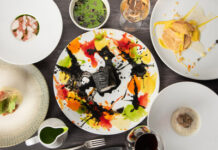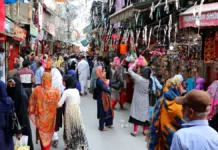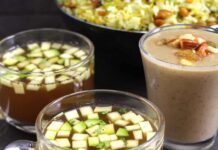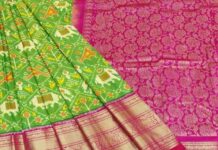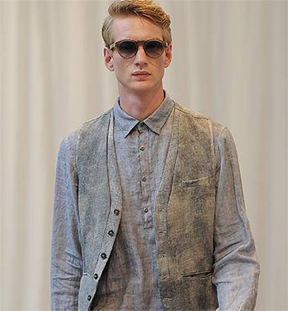 NEW DELHI: Khadi is attracting small upcoming fashion labels who are exploring possibilities to reinvent the intricate handspun fabric and keep it relevant in an industry driven by experimentation.
NEW DELHI: Khadi is attracting small upcoming fashion labels who are exploring possibilities to reinvent the intricate handspun fabric and keep it relevant in an industry driven by experimentation.
With chic silhouettes and eye-catching designs, the appeal of the natural fabric, which now comes in a variety of beautiful colors, has seen an upsurge, say designers.
“It isn’t too difficult to establish Khadi in niche and more expensive markets. However, the story is different for when it comes to cost-effective markets,” says Astha Vashisth, founder and designer at Delhi-based Fayakun Design Studios.
Vashisht has made it her business to re-invent woolen khadi from the valley of Ladakh and retail it in refreshingly different silhouettes in colors that range from natural indigos and breezy whites. The store provides interesting combinations of reds and mustard as well.
Given the predominantly hot climate, Khadi is the perfect fabric for the country. The Cotton Rack, a newly founded Jaipur-based women’s wear label, has decided to retain the organic appeal of the fabric and produce garments that blends comfort, style and detailing.
The brand’s founder Vinayak Sharma, alumni of NIFT says he wants to create khadi wear whose designs are as attractive as those from multi-national brands.
Laila Tyabji, founder of Dastkar, a Delhi-based NGO for craft says, “In my view Khadi ticks all the buttons as the global consumer becomes increasingly conscious of eco-friendly fabrics that have a low carbon footprint, are low cost, low maintenance, and handmade from natural materials that can breathe.”
The new face of khadi has introduced itself in a wide range from traditional kurtas in unique color combinations such as shades of maroon with mustard and black, navy blue with shades of yellow and lively colors of turquoise, pink and orange to the modern pin-tuck crop tops paired over sleeveless top, peplum tops, palazzos and shorts.
Noted names in the fashion industry Ritu Kumar, Sabyasachi Mukherjee, Gaurang Shah showcase a wide vibrant range from bridal collections in khadi to traditional sarees with work of jamdani, zari and gota-patti among many more.
“Thanks to the eminent designers, Khadi has become popular not worldwide. Fluidity of the fabric helps me work with Khadi,” said Priyanjoli Basu, Founder of the 2012 label Priyanjoli.
Priyanjoli specializes in making Khadi Western garments like skirts, shirts, pants among others.
The founder of the 2001 (check) label “GAURANG” which works on personifying elegance and captivating the beauty of traditional handlooms and weaves, Gaurang Shah, feels very happy with the rise of khadi in various products and forms.
He says, “What is even more delightful is the varied twists we brought into khadi like reducing the count from 100 to 80 and giving it different colors and textures to enhance its look and appeal, has gone very well with the fashion consumers.”
Talking about khadi as predominantly a white collection, he says designers and their weavers undertake various challenges to create myriad hues of khadi.
‘Gaurang’ has come out with khadi saris in purple and deep red. Some of his garments like off-shoulder flowy dresses with anarkali cuts, layered tunics and short tops teamed up with dhoti-style pants and the khadi jumpsuit with floral patterns have been showcased at international shows like Berlin Lavera Eco Fashion show.
“I designed a tree with branches, flowers and butterflies, woven along the length of the sari. A sari of this kind takes six months to weave,” says the Hyderabad-based designer. New innovations like these in recent years has helped put khadi among the most sought after piece for fashion shoppers.
Weavers need to be motivated continuously in order to have new intricate patterns in khadi that excites the craftsmen as well as consumers. We have introduced the dull looking khadi with flowers, leaves and birds in varying tonal quality, with the colors gradually moving from pastels to darker tones through the breadth of the sari. The three- shuttle technique that we used also helped get different colors in each border.” Shah adds.
Khadi has evolved from being a coarse fabric to a fashion forward textile that everyone is embracing. The finer finesse of the fabric has made future of Khadi as a more approachable, fashionable and durable fabric amongst the youth.
Rameshwari Kaul, co-founder of Cotton Rack, believes that Khadi is not a fabric but an ideology. “Khadi requires patience and persistence to be made into a fine quality garment. The product requires you to sit with the weavers and work with them in order to get optimum designs and results,” she says.
Khadi saw 125 per cent in sales after an appeal by Prime Minister Narendra Modi to promote the handwoven fabric by purchasing at least one khadi product. The government also took initiatives by organizing Khadi Paridhan Utsav at Delhi University’s colleges in order to connect youth with Khadi.
Industry insiders have pointed out the need for marketing khadi in a better way. Keeping the marketing needs in mind, the KVIC had first introduced a new range of trousers, jackets, and tops and recently launched a new range of khadi denim products that are claimed to be better in quality and comfort than the other denim products.
Citing examples of the success of organic fabrics like Malkha, Ssaha, BMKS, EcoTussar, and many others Tyabji points out that the time was right to promote khadi through new design and promotion strategies.-PTI

